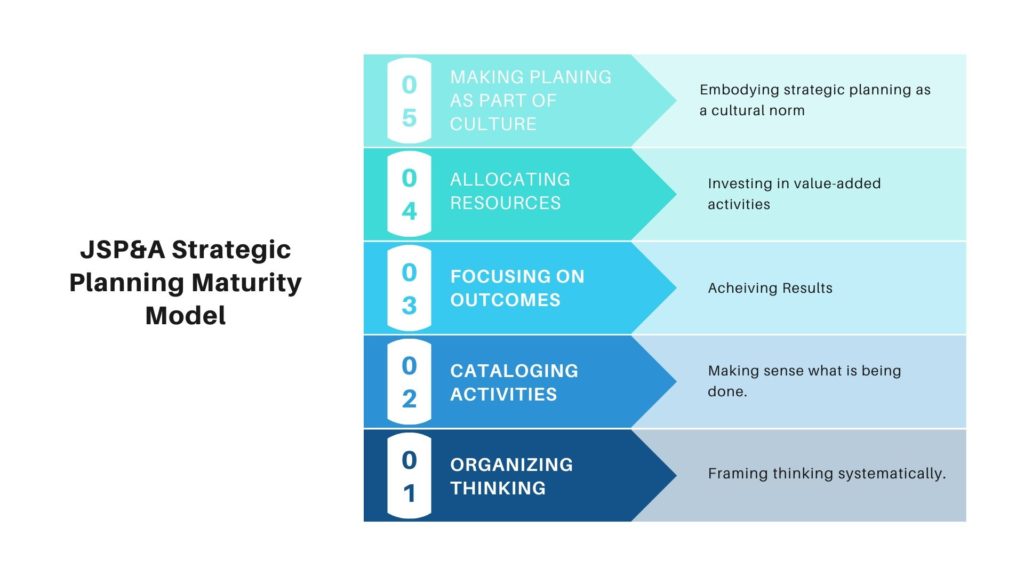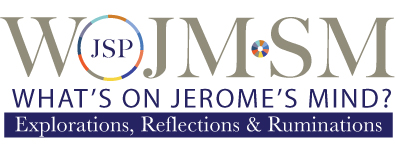
JSP&A Strategic Planning Maturity Model (SP-MM)
I am a fan of “stages of development models” or “maturity models.” Below is a model that we have developed. We base our model on our experiences with the HCWDC and other clients. We use this model to organize our thinking and to understand where groups are in the “strategic planning developmental process.”
“Stages of development models” are quite common. One that comes to mind is Maslow’s hierarchy of needs; another is Bloom’s taxonomy of learning; a third is “software capability maturity models.”
The JSP&A Strategic Planning Maturity Model (JSPA-SPMM) is a model of how an organization “matures” when using “strategic planning.” For us, the ultimate goal of a strategic plan is to provide direction for the allocation of organizational resources and to provide the context for turning strategy into action. The strategic planning process is part of an overall process of on-going organizational transformation – the process of reaching Stage 5.
Stage 1: Strategic Planning as Organizing Thinking
In Stage 1, strategic planning provides a framework to think systemically about what the organization is doing and what it would like to do. While there are lots of discussions about developing a mission, a vision, and objectives, what is going on, fundamentally, board members and stakeholders are engaging in collective thinking and developing a shared common language. While this an essential step to establish a shared common language, there is no real transformation of what the organization is doing and how it goes about doing it.
Stage 2: Strategic Planning as Cataloguing Organizational Activities
Stage 2 is similar to Stage 1 in that strategic planning provides a framework for taking the myriad of organizational activities and putting those activities into “boxes.” It provides a framework to “make sense” out of the types of activities in which an organization is engaged. Typically this includes a mixture of existing and new activities, with a preponderance of existing activities. The organization is using the strategic planning process to get a better understanding of what it has been doing, what it is doing, and what it would like to do.
Stage 3: Strategic Planning as Focusing on Outcomes
In Stage 3, the vision, mission, objectives, and activities get tied to a set of broad “outcomes.” For me, at this stage in the process, we introduce a performance measurement and management model to further group the activities and begin to set “numerical targets.” We frequently use a “logic model” that links the relationships among “input activities” and “process activities.” These “process activities” lead to “outputs,” and these “outputs” lead to “outcomes.”
In Stage 3, the organization gets focused on “outcomes,” the ultimate reason for the organization’s existence. Participants in the strategic planning process place the “internal strategic planning discussion” in the context of the shift that began in the late 1980s, particularly in the Federal Government to “performance.” Here the strategic planning process focuses on how an organization achieves “results” and on what “results” the organization wants to achieve.
Stage 4: Strategic Planning as Strategic Allocation of Resources
For an organization like the HCWDC, Stage 4 is critically important. In a lot of ways, the first three stages are “descriptive.” They outline what an organization is doing and what it would like to do. However, an organization has to address the “flip side” of this process as well. It has to decide what it is not going to do because resources (time and money) are limited. In one sense, Stage 4 is the key “stage” in that is requires an organization to make “trade-offs.” An organization has to decide what “to give up.” Stage 4 requires an organization to come to grips with its constraints. The “constraints” are, in one sense, “limiting factors.” Still, in another sense, they force an organization to invest in areas that create the most “value-added,” given the time and money the organization has. Stage 4 is the stage at which “strategic planning” really becomes “strategic.”
Stage 5: Strategic Planning Embodied In Organizational Culture
At Stage 5, “strategic planning” is no longer a periodic activity. As I noted above:
The ultimate goal of a strategic plan is to provide direction for the allocation of organizational resources and to provide the context for turning strategy into action. The strategic planning process is, in part, a process of organizational transformation.
Within the DiSC® model, “organizational culture” is defined as what an organization does and how it does it. In Stage 5, “strategic planning” has become an organizational cultural norm. “Strategic planning” has become the “new normal.”
The recent “Everything DiSC®” leadership model embodies this as well. In this model, “we are all leaders.” And as “leaders,” we all have to continually hone three critical skills – vision, alignment, and execution – skills that reinforce one another and that are fundamental to effective strategic planning.
At Stage 5, members of the organization embody “strategic planning
as a way of “doing business.” There is an internal, on-going process of refining and updating the strategic direction of the organization based on the performance information and data that is providing constant feedback to board members, staff, and stakeholders.

